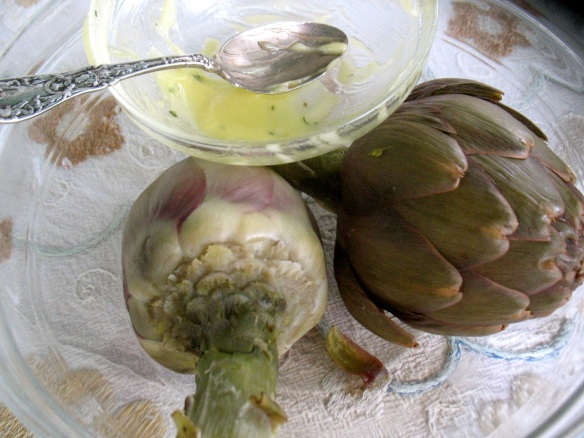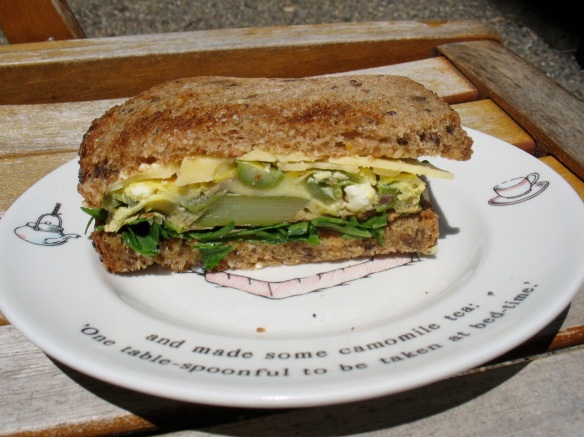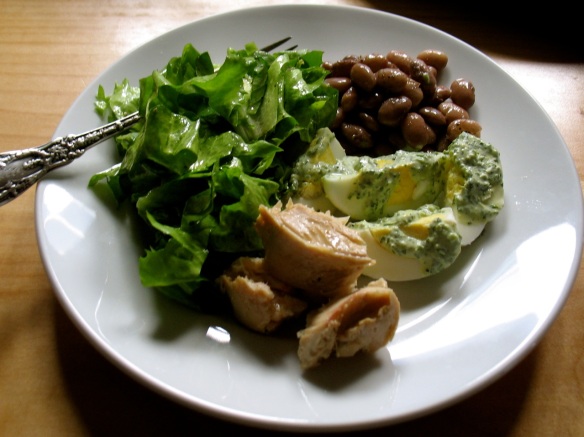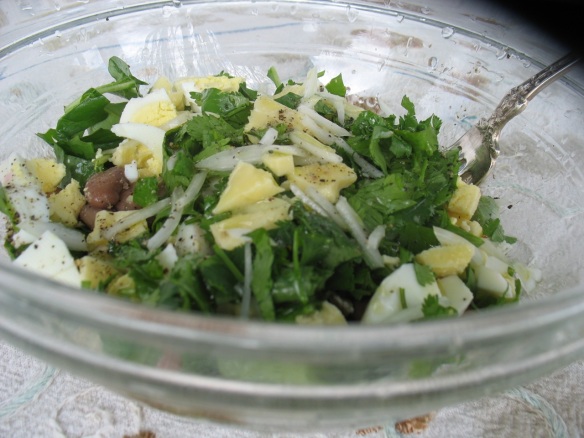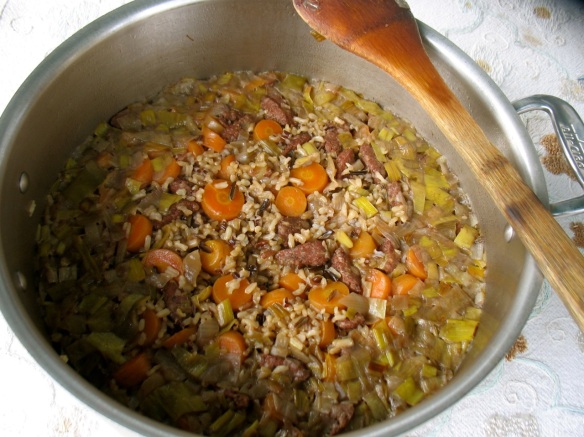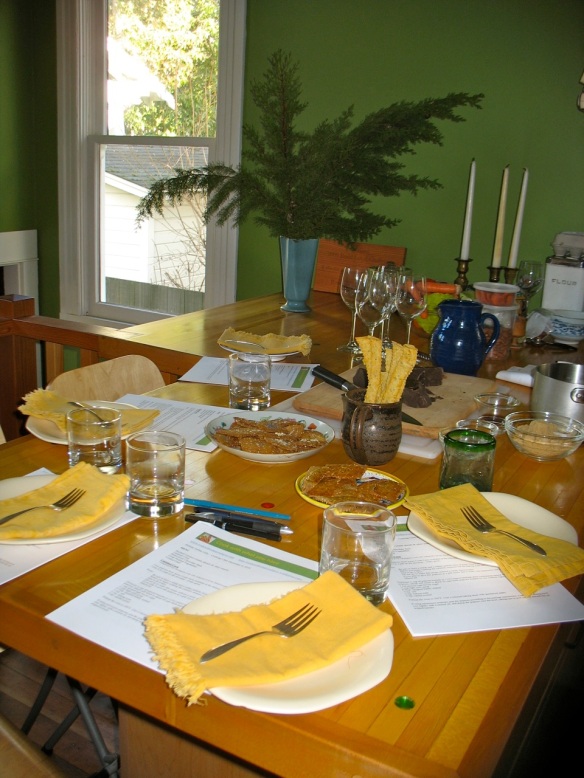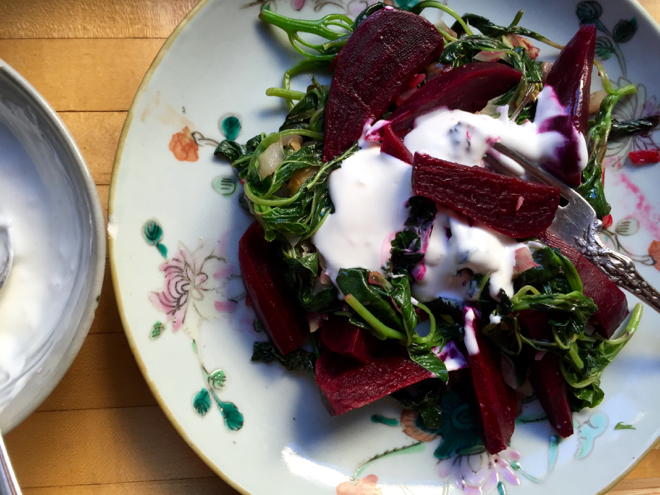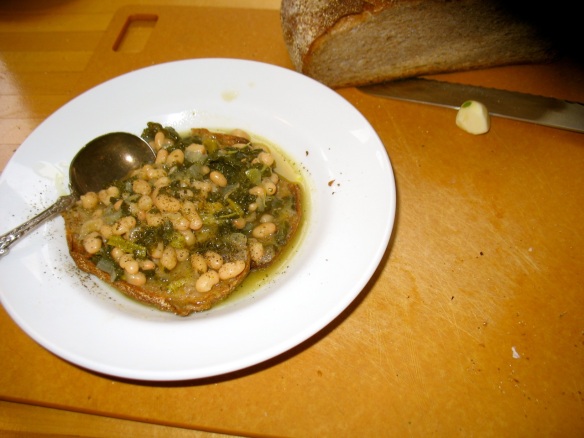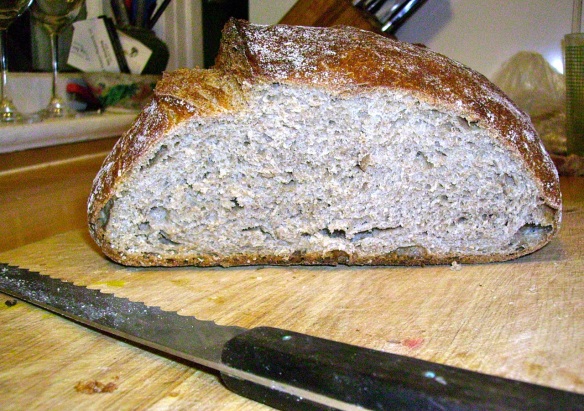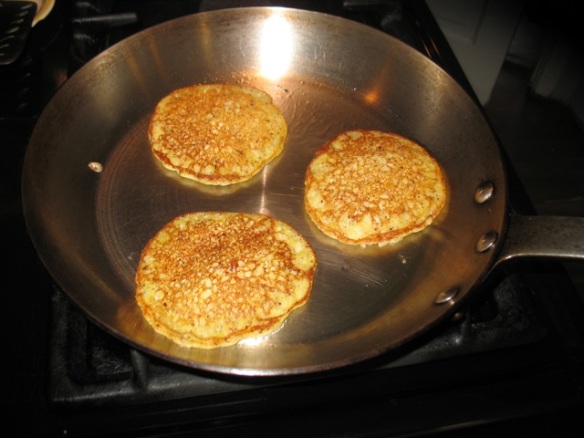
"Clean out the fridge" winter lunch
It’s taken me a year and a half to articulate what exactly it is I’m trying to do with my business–Cook With What You Have (through the classes I teach, this blog, etc.). The name really speaks for itself and even the words I used to describe the business/approach/philosophy at the outset are more or less the same ones I would use now. But these words, these ideas, are really sinking in in a more profound way than they did when I started this (ad)venture. They are sinking in thanks to my students, my neighbors, my chef friends, strangers in the grocery store and at the farmers markets, . . . And yesterday’s lunch!

Two kinds of cabbage and chard . . .
Yesterday’s lunch was a result of various factors: 1) the previous day had seen two birthday parties (one with kids from Ellis’ school and one with family members) laden with treats of all kinds, but plenty of sweet ones. 2) yesterday was also Superbowl Sunday and I knew there would be lots of heavy foods, and 3) I needed to clean out my fridge to make room for the new haul from Sunday’s Hillsdale Farmers Market run. I found 1/4 of green cabbage starting to brown around the edges, and 1/2 a red cabbage with similar signs and 1/2 a bunch of slightly wilty chard. After a rinse and a trim they looked much better (as do I:)!) and 10-15 minutes in the saute pan with a little olive oil and salt, they were damn near perfect.
So the above paragraph illustrates theme one of CWWYH (Cook With What You Have). Use what you’ve got. Now theme two (really en elaboration of theme one) would manifest itself as follows: If you like/have eggs on hand, scoot that cabbage over and fry a couple of eggs in the same pan. Serve them on top of the veggies sprinkled with good salt, drizzled with good olive oil and a few grinds of pepper. If you like/have bread on hand, toast a piece and dig in. If you like/have sausages in the freezer (like I do for just these occasions), slice one up and brown it and mix in.
Theme three might be considered the analytical part of the above story. Cooking can be fun, quick, delicious, cheap and not scary at all if you have things in your house you like, are not afraid to use salt and fat and taste the food as you’re preparing it. A little creativity can go a long way in making every day meals not so daunting.
And don’t get my wrong. I love cookbooks and recipes and food that’s a bit more involved than the above, but what we (collectively) seem to sometimes forget or not realize, is just how easy and fun and tasty food can be on the fly. And we get better and better at tossing things together like this if we have fresh produce on hand, experiment with ingredients we (our children, partners. . . .) like and are confident enough to look at a recipe and use it to our advantage rather than be enslaved by it.
Happy Cooking & Eating!
Katherine
P.S. Apropos fresh produce and local farmers (here in Oregon) there is a bill in the Oregon Legislature that will clarify and provide sound standards for on-farm production of items many of us love and rely on. Below is testimony by Anthony Boutard of Ayers Creek farm on the matter and an email for the committee administrator of House Bill 2336 in case you’d like to weigh in in support of this very well-crafted bill.
Committee Administrator, Liz Puskar: [email protected]
Testimony of Anthony Boutard in Support of HB 2336 Before The House Committee on Agriculture and Natural Resources 2 February 2011
Chairs Jenson and Clem, members of the committee,
For the record, my name is Anthony Boutard. My wife and I own and manage Ayers Creek Farm in Gaston, Oregon. We are small family fruit, vegetable and grain farm. We sell to grocery stores, restaurants and directly to the public. I served as a member of the committee’s working group that put together HB 2336.
At the outset, I want to thank my representative, Matt Wingard, for chairing the working group. He kept us on task and working productively. I also appreciate the contribution made by the staff of the Oregon Department of Agriculture (ODA) and the representatives of the Oregon Farmers’ Market Association (OFMA).
Over the last two decades, agriculture in Oregon has seen a marked increase in venues for selling agricultural products directly to the consumer. Farmers’ markets, community supported agriculture (CSA), and buying clubs have increased without a clear place in the regulatory structure. Historically, roadside stands selling produce, eggs and honey have been exempt from licensing, but these new venues stretch that definition. It is essential that the legislature provide statutory guidance on this issue, and I am grateful that the committee is doing so. As a farmer who sells directly to consumers, as well as processors and large retail stores, I believe this bill provides a balanced and sensible regulatory approach to direct marketing.
The bill identifies foods that, from a food safety perspective, are regarded as either non-hazardous, or minimally hazardous, and that can be safely produced by the farmer, and sold directly to the consumer without licenses or inspection. With the help of ODA staff, these definitions are also tightly drawn. Foods that pose a greater hazard, such sprouts, low-acid canned vegetables and fruits, and baked goods, are not included and must be processed in a licensed facility. It must be stressed that farmers’ market rules still prevail, regardless of licensing requirements. These organizations will still determine who can participate in the market, and what they can sell.
With its provisions regarding preserves and pickles, this bill provides room for innovation at the small farm level. New ideas invariably start at this level whether it is in some one’s kitchen or garage. Oregon’s craft brewing industry developed after laws prohibiting the brewing and selling of beer in the same establishment. Allowing farmers to try out new products at a small, manageable scale is an important step in fostering innovation. HB 2336 also includes a provision that allows the ODA to expand the list of foods that can be prepared at the farm, consistent with food safety. With the $20,000 annual limit on sales of these foods, the bill set up a clear threshold where the farmer must shift into a licensed facility.
I urge the committee to pass this bill with a “do pass” recommendation. The lack statutory clarity has festered too long and all of parties involved, the ODA, the farmers, and farms’ market organizations, need the guidance provided by this bill.
Thank you for the opportunity to testify in support of HB 2336.
Anthony Boutard
Ayers Creek Farm
Gaston, Oregon

